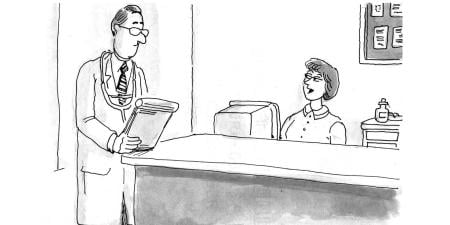Case
Renee is a 28-year-old woman with asthma who came to the emergency room with a cough, a fever, and difficulty breathing. She was diagnosed with pneumonia and an asthma exacerbation. She was started on IV antibiotics and given nebulized treatments every 2 hours. Based on her age and the diagnosis of community-acquired pneumonia, Renee was approved for a 2-day admission by the HMO that manages her health benefits .
Renee continued to have a fever more than 24 hours into her admission and was switched to oral antibiotics on the morning of the second day. That morning she still required nebulized treatments every 3 to 4 hours. Her blood oxygen saturation was normal as long as she remained still, but she desaturated slightly to 94 percent with minimal exertion.
Allison is the resident taking care of Renee and is concerned that Renee is not doing well enough to be discharged. Allison would like to keep Renee in the hospital another day to ensure that she remains afebrile on oral antibiotics and that she is able to go 4 hours between treatments. The HMO, however, refuses to authorize additional inpatient care. The HMO has authorized payment for a home nebulizer for Renee, and the administrator for the plan feels that someone of Renee's age with her history should not require additional inpatient care.
Allison discusses Renee's care with her team on rounds.
After presenting the medical facts, Allison concludes, "I really think she needs 1 more day in the hospital. She will probably be fine, but she's just a little too on the edge for my comfort. If she gets worse at home it could mean several days in the hospital to get control of things again. It's even possible that she could get worse so quickly that she could die, although I think that is extremely unlikely. If we observe her here for another day we can make sure she's stable and respond quickly to her if she gets worse."
Dr. Barnes, the attending says, "Without the HMO's prior approval the hospital probably won't get paid for the extra day. It's that kind of thing that contributes to everyone's health care being so expensive. The hospital has to make up the difference somewhere, or they can't stay open."
Another resident, Pat, contributes, "I think it is fine to send her home. It's not like she absolutely has to be here. We think she will probably be fine at home. She has resources at home to manage her care, and she can come back if she needs to. HMOs base their length of stay approvals on data—how long should it take to care for someone in this condition? They keep things from getting out of control by observing people in the hospital until there is no risk of getting worse. If Renee were really in need of hospital care, I know we would all agree that she had to stay whether we get paid or not, but she probably doesn't need hospital care. This is one of the times where the HMO may be right—they help the system and the patient by encouraging prompt discharge."
Commentary 2
Clinical errors go by many names, including "adverse events." More often than not, those errors are made possible—or even made more likely—by background conditions of the system. Evidence-based medicine (EBM) has been hailed as the answer to myriad problems, including improving patient safety, but it is a double-edged sword. Tension exists in the developing field of EBM. EBM has been considered a movement to apply scientific methodology to evaluate the safety, effectiveness, and cost of medical practices. Yet, at the same time it has been criticized as undermining the physician's personal experience and professional autonomy and the relationship of trust between patient and physician, as a stalling tactic by institutions, and as a justification for rationing decisions. This case deals with conflicts between health plan benefits and medical judgment that might be resolved or lessened with proper application of evidence-based medicine. I will give a relevant example.
In their article "Instability on Hospital Discharge and the Risk of Adverse Outcomes in Patients With Pneumonia,"1 researchers Halm et al put forth 7 indicators of the instability of a pneumonia patient, the notion being that these 7 criteria are objectively verifiable. The results demonstrated that these indicators of poor outcomes in pneumonia patients allowed clinicians to identify patients at high risk for complications. As with any study, there were limitations to the design, but rather than focusing on the "lack of evidence" presented by the limitation of the study, the authors chose to emphasize the impact on individual patient's welfare. By indicating that their data and study should be used as a "complementary [emphasis added] patient safety indicator" the authors avoid the ethical pitfall of undermining the individual physician's personal experience and potentially compromising the patient's safety. Supporters of EBM would argue that this study reflects the best of EBM: "the conscientious, explicit, and judicious use of current best data in making decisions about the care of individual patients."2
It seems obvious that medical decision making must be based on something other than intuition or anecdotal observation. With the enormous volume of knowledge available today, a systematic approach to clinical care is required. With the advent of computerized surgery, nanotechnology, and gene-specific treatments, EBM is an increasingly necessary part of clinical practice. In fact, computerized decision support (CDS) systems are being marketed to general practitioners as well as to specialists through a variety of medical informatics programs at large universities.
A philosopher friend of mine once asked me whether I would rather have an incredibly accurate computer or a potentially fallible human for a physician. My immediate reaction was, "a human, of course." When my friend pressed me for the reason, my response was that care, trust, sympathy, and intuition were not characteristics a computer could offer; the same certainly could be said about EBM, depending on its application. My friend rightfully pointed out that in a medical malpractice action, a court would give little or no weight to those factors, focusing instead on accuracy or the "standard of care." In a court system's adversarial proceeding that allows each party to present evidence and experts in support of its claims and to cross-examine, discredit, and rebut the expert witness of the opposing party, EBM is favored. This approach was solidified by the United States Supreme Court in the case of Daubert vs Merrill Dow Pharmaceuticals, where the Court held that the judge must determine the validity of scientific expert opinion and ascertain its reliability and usefulness to the jury. The Court went on to explain:
Many considerations will bear on the inquiry [of relevance and admissibility], including whether the theory or technique in question can be (and has been) tested, whether it has been subjected to peer review and publication, its known or potential error rate, and the existence and maintenance of standards controlling its operation, and whether it has attracted widespread acceptance within a relevant scientific community. The inquiry is a flexible one, and its focus must be solely on principles and methodology [emphasis added], not on the conclusions that they generate.3
As with so many issues in medical ethics, it isn't entirely clear whether EBM is a positive development for patient safety or not. There may not be good evidence for all questions, and some questions are not amenable to rigorous study. Additionally, as with any instrument forged by science, there is potential for abuse; EBM is not necessarily value-neutral or impartial.
I have described the clinical applicability of EBM and its legal standing at some length because I think it could be instrumental for determining whether it is safe to discharge Renee. There is evidence on the specific issue of pneumonia and complications. When such evidence exists, it should be reviewed carefully and should not be ignored lightly. If the evidence suggests that a patient like Renee will have a poor outcome, then it is reasonable to challenge the HMO and to present that evidence as the basis for the challenge. If the evidence indicates that Renee is not at risk for complications or has received adequate care to minimize the complications, then the HMO policy is doing its job and minimizing length of stay to appropriate duration.
Appropriate evidence-based decision making is, and will continue to be, a balancing act for clinical practitioners. In addition to the resource implications for which EBM has become so popular, the more important question to ask is: "What are the ethical implications?" The role of physicians in promoting the patient's welfare, respecting patient autonomy, and preserving the trust in the patient-physician relationship are key factors to consider when asking this question. Clinicians should recognize and use evidence-based recommendations within the context of clinical judgment, but clinicians must also recognize that evidence is persuasive, and it helps resolve dilemmas such as the one Renee's physicians face.
References
- Halm EA, Fine MJ, Kapoor WN, Singer DE, Marrie TJ, Siu AL. Instability on hospital discharge and the risk of adverse outcomes in patients with pneumonia. Arch Intern Med. 2002;162(11):1278-1284.
-
Kamerow DB. Clinical evidence: creation, assessment, and implementation. Presented at: the Agency for Health Care Policy and Research's conference Translating Evidence Into Practice: What Do We Know? What Do We Need? July 21-23, 1997; Washington, DC. Accessed February 17, 2004.
-
Daubert v Merrill Dow Pharmaceuticals, Inc, 509 US 579, 113 S Ct 2786, 125 L Ed 2d 469, 61 USLW 4805, 1993 US LEXIS 4408, June 28, 1993.



